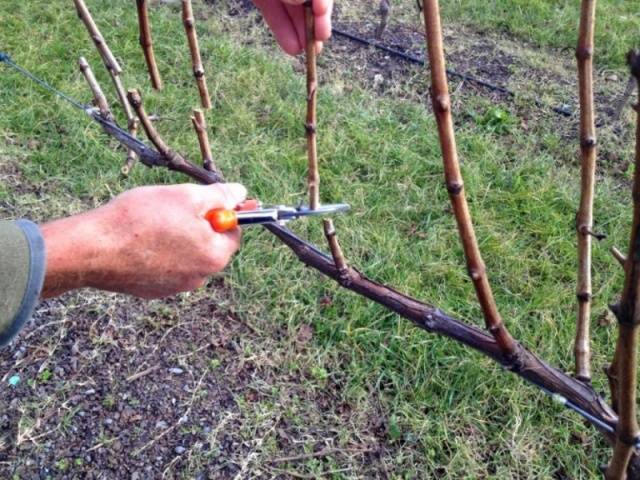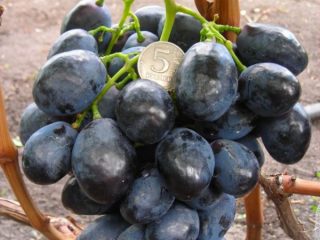Content
The Krasotka grape variety was bred in 2004 by breeder E.E. Pavlovski as a result of crossing the Victoria variety and the European-Amur varieties of this crop. The new variety received its name for its attractive appearance and high taste. Below is a description of the Krasotka grape variety, photos, and reviews from gardeners.
Characteristics of the variety
Variety Beauty corresponds to the following description:
- medium-sized bush;
- large elongated clusters weighing from 0.5 to 1 kg;
- bisexual flowers;
- Grape ripening period is from 105 to 115 days;
- the berries are arranged freely on the bunch;
- fruit shape – ovoid-elongated;
- grape color is dark pink in the middle and purple at the tips;
- pleasant refreshing taste;
- the pulp of the Krasotka variety has light nutmeg notes and a vanilla flavor;
- sugar content – 15%.
Krasotka grapes have an excellent presentation, the clusters are distinguished by good transportability. It is not recommended to keep the fruits on the bushes for too long, as the skin will burst and the pulp will soften.
The variety does not have high yields, but fruiting is stable.The root system of the plant is powerful, capable of providing the plant with nutrients. Seeds are rarely found in fruits; their number is no more than two.
Grapes Beauty has the following advantages:
- resistance to sunlight (there are no burns on the berries);
- frost resistance up to -23 degrees;
- is not subject to gray rot and oidium;
- good resistance of the variety to anthracnose and mildew;
- attractive appearance;
- sweet taste;
- early stable harvest.
Description of the Krasotka grape variety corresponds to the photo:
Boarding order
The development of the Krasotka grape variety depends on the correct choice of location on the site. Before planting, it is important to prepare the soil. Be sure to apply fertilizers that promote plant development.
Selecting a location
To plant grapes, choose a sunny place, protected from the wind. It is best to locate the vineyard on the southern and southwestern slopes. The maximum permissible tilt is 25 degrees.
The soil should have medium acidity. Forest or black soil soil is suitable for growing grapes. On light loam or loose soil with a high sand content, caring for the Krasotka variety is much easier. The groundwater level is at least 1.5 m from the surface.
Preparing the soil for planting begins 3 months before the start of work. First, the area is cleared of stones and plant debris (tree bark, weeds, remains of previous cultures). The soil is dug up to a depth of 1 m.
A drainage layer is made in the recess using crushed stone, sand and broken bricks.Then fertilizers are placed at its bottom: superphosphate (200 g), compost, manure, ammonium sulfate, ash. A layer of soil is placed on top. Horse and goat manure is added to heavy soils, while cow and pig manure is used for loamy soils.
If planting is planned in the spring, then the prepared hole is left for the winter. When planting in autumn, work begins in mid-summer.
Landing Features
It is recommended to purchase grapes from specialized centers. When choosing a seedling, you need to pay attention to its root system, which should include 2 or 3 white roots. The shoots must contain at least 3 blossoming leaves.
A one-year-old seedling has an even and strong trunk. Its length is about 20 cm. The number of buds on the shoots is more than 6 pieces.
Grape cuttings are placed in a hole so that the root system is located at a distance of 0.5 m from the surface. The seedling is sprinkled with garden soil and tied to a support. Then pour 2 buckets of water under each bush. When the soil settles a little, the soil is mulched with straw or agrofibre.
Rules of care
Caring for a vineyard includes a number of standard procedures: watering and fertilizing, pruning, protection from diseases and pests. Proper poly will help avoid fruit cracking. Fertilizing will provide the vineyard with nutrients and improve the taste of the berries.
Watering grapes
Special holes are prepared for watering the grapes. To do this, at a distance of 30 cm from the plant, draw a circle in which several depressions are made. In the first year after planting, the grapes are watered once a week.
The main disadvantage of the Krasotka variety is cracking of the berries.This happens in sunny and rainy weather, with or without watering. To harvest before the berries crack, you need to load the plant minimally. The bunches are pruned immediately after ripening. If you postpone the procedure for several days, you may lose part of the harvest.
Regular watering, which introduces a small amount of moisture, helps to avoid cracking of the berries. It is also necessary to spray the plantings with a solution of calcium nitrate.
Fertilizing
In the first year after planting, the Krasotka grape variety does not require fertilizing. The plant will receive all the necessary substances from the fertilizers used during planting. The following year in the spring, nitrogen-containing substances (50 g), superphosphate (40 g) and potassium (30 g) are added to each bush.
Before flowering, fertilizing the Krasotka variety is repeated, but the substances are dissolved in 2 buckets of slurry. Before use, the resulting mixture is diluted with water 1:5.
During the flowering period, grapes are treated with the growth stimulant Gibberellin. This avoids cracking of the berries and peas, and also speeds up the ripening of the bunch.
The Krasotka variety will require additional feeding when the ovary appears. Substances with nitrogen, phosphorus and potassium will need 30 g each. They are diluted in 10 liters of water and applied by watering. A similar amount of substances, with the exception of nitrogen, is used at the berry ripening stage. They are embedded in the ground and the vineyard is watered.
Trimming and covering
The Krasotka grape variety is cut into 5-8 buds. The grapes form powerful and long shoots. If you cut them too short, part of the harvest is lost and active growth of branches is provoked. In the spring, the load on the bush is additionally adjusted.
Before covering the grapes for the winter, cut off excess shoots and water the bushes abundantly (10 liters of water for each plant). The vine must be removed from the support and laid on the ground. Agrofilm is used as a covering material.
Protection from diseases and pests
The Krasotka variety is resistant to major vineyard diseases. To prevent them, it is recommended to treat plantings with complex preparations Acrobat, Quadris or Champion.
Weeds growing around the vineyard attract leafhoppers and other pests. Therefore, weeds must be removed in a timely manner. Sweet berries attract birds, so it is recommended to cover the bunches with gauze bags.
Another pest of Krasotka grapes is wasps. They are capable of chewing through gauze, so another method is used to combat them. The grapes are sprayed with a solution consisting of mustard (200 g) and water (1 bucket). Mustard does not affect the taste of the fruit, and after harvesting it can be easily washed off.
Reviews from gardeners
Conclusion
According to the photo and description of the Krasotka grapes, the variety has excellent external characteristics and is suitable for further sale in fresh form. With proper care, you can avoid cracking of the berries and harvest large harvests of grapes. Plantings need watering and regular fertilizing. For prevention, it is recommended to treat grapes with anti-disease agents.

















